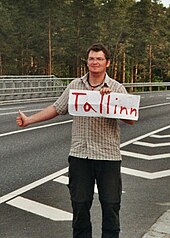Hitchhiking



Hitchhiking(also known asthumbing,autostoporhitching) is a means oftransportationthat is gained by asking individuals, usually strangers, for a ride in theircaror other vehicle. The ride is usually, but not always, free.
Signaling methods
[edit]
Hitchhikers use a variety of signals to indicate they need a ride. Indicators can be physical gestures or displays including written signs.[1]The physical gestures, e.g., hand signals, hitchhikers use differ around the world:
- In some African countries, the hitchhiker's hand is held with the palm facing upwards.[2]
- In most of Europe, North America, South America and Australia, most hitchhikers stand with their back facing the direction of travel. The hitchhiker typically extends their arm towards the road with the thumb of the closed hand pointing upward or in the direction of vehicle travel.[2]
Legal status
[edit]
Hitchhiking is historically a common practice worldwide and hence there are very few places in the world where laws exist to restrict it. However, a minority of countries have laws that restrict hitchhiking at certain locations.[3]In the United States, for example, some local governments have laws outlawing hitchhiking, on the basis of drivers' and hitchhikers' safety. InCanada,several highways have restrictions on hitchhiking, particularly inBritish Columbiaand the400-series highwaysin Ontario. In all countries in Europe, it is legal to hitchhike and in some places even encouraged. However, worldwide, even where hitchhiking is permitted, laws forbid hitchhiking where pedestrians are banned, such as theAutobahn(Germany),Autostrade(Italy),motorways(United Kingdom and continental Europe, with the exception of, at least, Lithuania) orinterstate highways(United States), although hitchhikers often obtain rides at entrances and truck stops where it is legal at least throughout Europe[4][5]with the exception of Italy.[6]
Community
[edit]In recent years, hitchhikers have started efforts to strengthen their community. Examples include the annualHitchgathering,an event organized by hitchhikers, for hitchhikers, and websites such ashitchwiki,which are platforms for hitchhikers to share tips and provide a way of looking up good hitchhiking spots around the world.
Decline
[edit]In 2011,Freakonomics Radioreviewed sparse data about hitchhiking, and identified a steady decline in hitchhiking in the US since the 1970s, which it attributed to a number of factors, including a greater lack of trust of strangers, lower air travel costs due to deregulation, the presence of more money in the economy to pay for travel and more numerous and more reliable cars.[7]A marked increase in fear of hitchhiking is thought to have been spurred by movies such asThe Texas Chain Saw Massacre(1974),The Hitcher(1986), and a few real incidents involving imperiled hitchhikers, including thekidnapping of Colleen Stanin California.[7]See§ Safety,below.
Some British researchers discuss reasons[further explanation needed]for hitchhiking's decline in the UK, and possible means of reviving it in safer and more-organized forms.[8]
Public policy support
[edit]
Since the mid-2010s, local authorities in rural areas in Germany have started to support hitchhiking, and this has spread to Austria and the German-speaking region of Belgium. The objectives are both social and environmental: as ride sharing improves mobility for local residents (particularly young and old people without their own cars) in places where public transport is inadequate, thus improving networking among local communities in an environmentally friendly way. This support typically takes the form of providinghitchhiking benches(in GermanMitfahrbänke) where people hoping for a ride can wait for cars. These benches are usually brightly coloured and located at the exit from a village, sometimes at an existing bus stop lay-by where vehicles can pull in safely. Some are even provided with large fold-out or slide-out signs with place names allowing hitchers to clearly signal where they want to go. SomeMitfahrbänkehave been installed with the help of the EU'sLEADER programmefor rurallocal development[9]
In Austria,Mitfahrbänkeare especially common inLower AustriaandTyrol,and are promoted by theFederal Ministry of Agriculture, Regions and Tourismunder itsklimaaktivclimate protection initiative.[10]In 2018 the TyroleanMobilitäterInnennetwork published aManual for the Successful Introduction of Hitch-hiking Benches.[11]
Safety
[edit]Limited data is available regarding the safety of hitchhiking.[12]Compiling good safety data requires counting hitchhikers, counting rides, and counting problems, all difficult tasks.[13]
Two studies on the topic include a 1974California Highway Patrolstudy and a 1989 German federal police (Bundeskriminalamt Wiesbaden) study.[12]The California study found that hitchhikers were not disproportionately likely to be victims of crime.[14]The German study concluded that the actual risk is much lower than the publicly perceived risk; the authors did not advise against hitchhiking in general.[15]They found that in some cases there were verbal disputes or inappropriate comments, but physical attacks were very rare.[16]
Recommended safety practices include:[17]
- Asking for rides at gas stations instead of signaling at the roadside
- Refusing rides fromalcohol impaired drivers
- Hitchhiking during daylight hours
- Trusting one's instincts
- Traveling with another hitchhiker; this measure decreases the likelihood of harm by a factor of six[18]
Around the world
[edit]
Cuba
[edit]In Cuba, picking up hitchhikers is mandatory for government vehicles, if passenger space is available. Hitchhiking is encouraged, as Cuba has few cars, and hitchhikers use designated spots. Drivers pick up waiting riders on a first come, first served basis.[19]
Israel
[edit]In Israel, hitchhiking is commonplace at designated locations calledtrempiyadas(טרמפיאדה inHebrew,derived from theGermantrampen). Travelers soliciting rides, calledtrempists,wait attrempiyadas,typically junctions of highways or main roads outside of a city.
Poland
[edit]Hitchhiking inPolandhas a long history and is still popular. It was legalised and formalised in 1957 so hitchhikers could buy booklets including coupons from travel agencies.[20]These coupons were given to drivers who took hitchhikers. By the end of each season drivers who collected the highest number of coupons could exchange them for prizes, and others took part in a lottery. This so-called "Akcja Autostop" was popular till the end of the 1970s, but the sale of the booklet was discontinued in 1995.[21]
United States
[edit]Hitchhiking became a common method of traveling during theGreat Depressionand during the Counterculture of the 1960s.

Warnings of thepotential dangers of picking up hitchhikerswere publicized to drivers, who were advised that some hitchhikers would rob drivers and, in some cases, sexually assault or murder them. Other warnings were publicized to the hitchhikers themselves, alerting them to the same types of crimes being carried out by drivers. Still, hitchhiking was part of the American psyche and many people continued to stick out their thumbs, even in states where the practice had been outlawed.[22]
Today, hitchhiking is legal in 44[which?]of the 50 states, provided that the hitchhiker is not standing in the roadway or otherwise hindering the normal flow of traffic. Even in states where hitchhiking is illegal, hitchhikers are rarely ticketed. For example, theWyoming Highway Patrolapproached 524 hitchhikers in 2010, but only eight of them were cited (hitchhiking was subsequently legalized in Wyoming in 2013).[23]
See also
[edit]- Murders of Jacqueline Ansell-Lamb and Barbara Mayo– two unsolved murders of hitchhikers in England in 1970
- Carpool
- Flexible carpooling– hitchhiking formalized via designated meeting points
- Freighthopping
- Hitchwiki
- Ridesharing company
- Slugging– hitchhiking motivated byhigh-occupancy vehicle lanesin several urban areas
References
[edit]- ^Kovalchik, Kara (9 January 2015)."Why Do Hitchhikers Say" (Destination)...Or Bust! "?".Mental Floss.
- ^ab"Hitchhiker's guide - what you should know?".myluggage.io.Retrieved30 July2022.
- ^Nwanna, p.573
- ^"Hitchhiking Basics".
- ^"Hitchhiking".Archived fromthe originalon 7 December 2012.Retrieved4 December2012.
- ^"Italy - Hitchwiki: The Hitchhiker's guide to Hitchhiking".
- ^abHuynh, Diana (10 October 2011)."Where Have All the Hitchhikers Gone?".Freakonomics Radio Podcast.Archived fromthe originalon 15 September 2016.Retrieved21 September2016.
- ^Chesters, Graeme; Smith, David (2001)."'The Neglected Art of Hitch-hiking: Risk, Trust and Sustainability ".Sociological Research Online.6(3): 63–71.doi:10.5153/sro.605.S2CID143681275.
- ^Bianca Frieß (10 August 2018)."Projekt: Nersingen will Mitfahrbänke aufstellen".Südwest Presse.Archived fromthe originalon 25 April 2019.Retrieved25 April2019.
- ^"Die Mitfahrbank als unkomplizierte Mitfahrbörse für alle BürgerInnen".Österreichisches Bundesministerium für Nachhaltigkeit und Tourismus. 20 August 2018. Archived fromthe originalon 29 September 2020.Retrieved25 April2019.
- ^Handbuch für eine erfolgreiche Einführung von Mitfahrbänken(PDF).MobilitäterInnen. 2018.Archived(PDF)from the original on 25 April 2019.
- ^abWechner, Bernd."A dearth of research: Does anyone really know anything about hitch-hiking?".
- ^Wechner, Bernd."The Pros and Cons of Hitch-Hiking".bernd.wechner.info.
There are no statistics on hitch-hiking, at least none that are meaningful and reliable. Compiling useful statistics would require counting hitchers and the amount of rides they receive, and comparing them to the problems reported, which would be a difficult task.
- ^McLeod, Jamie (10 January 2007)."The 'better' Better Way".The Eyeopener.Retrieved3 May2013.
The most recent hard evidence I could find about hitchhiking danger was a 1974 study conducted by the California Highway Patrol examining crimes committed by and on hitchhikers. It found that in 71.7 per cent of hitchhiker related crimes the hitchhiker was the victim. It also found that only 0.63 per cent of the crimes reported during the period of the study were hitchhiker-related, and that hitchhikers were not disproportionately victims of crime.
Citing:"California Crimes And Accidents Associated With Hitchhiking".California Highway Patrol. February 1974.No independent information exists about hitchhikers who are not involved in crimes. Without such information, it is not possible to conclude whether or not hitchhikers are exposed to high danger. However, the results of this study do not show that hitchhikers are over-represented in crimes or accidents beyond their numbers.
Also available asa PDF. - ^Joachim Fiedler; et al. (1989)."Anhalterwesen und Anhaltergefahren: unter besonderer Berücksichtigung des" Kurztrampens ""(in German). Wiesbaden, Germany: Bundeskriminalamt Wiesbaden.OCLC21676123.
- ^"Trampen ohne großes Risiko".Zeit Online.1990."In one of 10,000 rides, a woman is raped and in two of 1,000 rides, there is an attempted rape."
- ^"Hitchhiker's safety".Hitchwiki.Retrieved1 January2014.This is a link to the referenced article; but, note that it has not been fully peer-reviewed, and that we cannot guarantee its validity.
- ^Based on:Compagni Portis, Julian (2015).Thumbs Down: America and the Decline of Hitchhiking(BA thesis). Wesleyan University. p. 44.Citing:"California Crimes And Accidents Associated With Hitchhiking".California Highway Patrol. Table 18.Also available asa PDF.
- ^Cuba Hitchhiking GuideArchived27 November 2012 at theWayback Machine
- ^"booklets".Archived fromthe originalon 10 July 2010.Retrieved20 October2012.
- ^Jakub Czupryński (red.), "Autostop polski. PRL i współczesność", Korporacja Ha!art, Kraków 2005.ISBN83-89911-18-3
- ^Dooling, Michael C. (2010).Clueless in New England: The Unsolved Disappearances of Paula Welden, Connie Smith and Katherine Hull.The Carrollton Press.
- ^Laura Hancock (13 January 2013)."Wyoming Senate committee debates, advances hitchhiking bill".Casper Star-Tribune.Retrieved30 May2014.
Bibliography
[edit]- Brunvand, Harold (1981).The Vanishing Hitchhiker. American Urban Legends and Their Meaning.New York NY: Norton & Company.
- Griffin, John H. (1961).Black Like Me.Boston: Houghton Mifflin.
- Hawks, Tony (1996).Round Ireland with a Fridge.London: Ebury.
- Laviolette, Patrick (2016).Why did the anthropologist cross the road?Ethnos: Journal of Anthropology.81(3): 379–401.
- Nwanna, Gladson I. (2004).Americans Traveling Abroad: What You Should Know Before You Go,Frontier Publishers,ISBN1890605107.
- Packer, Jeremy (2008). Hitching the highway to hell: Media hysterics and the politics of youth mobility.Mobility Without Mayhem: Safety, Cars, and Citizenship.Chapel Hill: Duke Univ. Press (77–110).
- Reid, Jack. (2020)Roadside Americans: The Rise and Fall of Hitchhiking in a Changing Nation.Chapel Hill: Univ, of North Carolina Press.
- Smith, David H. & Frauke Zeller (2017). The death and lives of hitchBOT: the design and implementation of a hitchhiking robot.Leonardo.50(1): 77–8.
- Sykes, Simon & Tom Sykes (2005).No Such Thing as a Free Ride.UK Edition. London: Cassell Illustrated.
- Tobar, Héctor (2020).The Last Great Road Bum.New York: Farrar, Straus and Giroux.
- Kabourkova, Michaela (2022).Solo Female Traveller: What I Learnt from Hitchhiking in 70 Countries.Valencia: Amazon.
